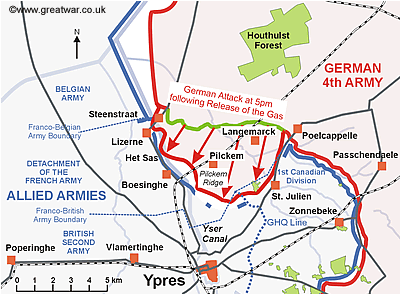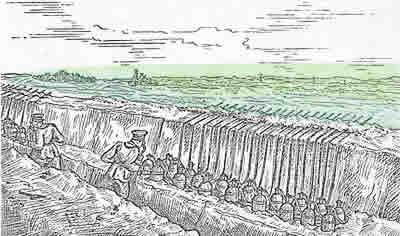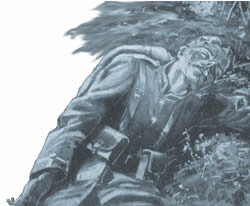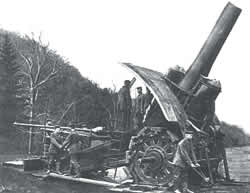 German gains by the end of the day
German gains by the end of the day
22 April 1915: 24.00
By the end of the day on 22nd April the ground gained by the German 4th Army was that:
- the XXIII. Reserve Korps had thrown the enemy back over to the west bank of the Yser Canal between Steenstraat and Het Sas.
- the XXVI. Reserve Korps had broken through the Allied front as far as a line from the south of Pilckem to the north-west of St. Julien.

However, the Belgians and the British were stubbornly defending the two important Army boundary junctions at both ends of the German line of attack. The continued success of a German advance towards Ypres or the consolidation of the new line would have to deal with this in order to avoid getting the German troops into the dangerous situation. Their soldiers could find themselves trapped in a salient. This would be disadvantageous in so far as the German left, right and even rear flanks could be exposed to attack.
Results of the Trial Gas Attack
The successful effect of the gas on the central area of the attack enabled the rapid, unhindered advance by the 52. Reserve Division towards Pilckem Ridge. The French were surprised and terrified by the horrific effects of this gas. The way in which these soldiers abandoned their positions and fled for their lives shows how the new weapon caused not only a physical effect. It also produced an extreme psychological reaction - wild panic.
However, at both the right and left ends of the German attacking line there were problems with the emission of the gas.
On the right end of the German attack at Steenstraat the batteries of gas cylinders had not released their gas successfully. The wind direction had actually blown the gas cloud further to the south into the French sector instead of westwards across the canal towards the Belgians. This meant that the Belgian troops holding the junction of the Franco-Belgian Boundary at Steenstraat were relatively unscathed. They were able to defend the Allied line at an important junction. They then had a hold on a position on the west of the broken Allied line and, therefore, were able to pose a threat to the right flank of the German attack.
On the extreme left end of the German attack the Canadian 3rd Brigade was holding the left of the British line on the Franco-British Boundary. The front along which the gas was released was not extended as far as the Canadian font at the Franco-British Boundary. The troops of the two Canadian battalions in the line and those in reserve at St. Julien were initially unscathed by the gas cloud. Some French soldiers in the 1st Company Tirailleurs, who were on the far right of the French line near the Franco-British Boundary, also escaped the effects of the cloud because it was not released directly towards them. This enabled the Canadians and some French troops to put up a defensive flank facing a north-westerly direction at the junction of the Franco-British Boundary.
Criticism of the New Method of Warfare

The history of the 238 Reserve-Infanterie-Regiment of 52. Reserve Division(1) comments on the major flaw of such a chemical weapon in its total reliance on the wind and the weather. The attack was postponed a total of three times. Even on the third attempt at successfully releasing the gas from the canisters, the wind dropped on the early morning of 22nd April. This prompted the German commanders, some of them reluctantly, to move the attack to the late afternoon. Their hope was that it could be carried out after all now that the troops were in their attack positions for a third time. The 213 Reserve-Infanterie-Regiment (2) history writes that the 46. Reserve Division commander (Generalleutnant von Hahn) and the XXIII. Reserve Corps commander (General von Kathen) expressed their concerns about launching an infantry attack following the gas in broad daylight. Not wanting to prolong the tension of this frustrating ‘on/off’ situation for the gas attack the 4th Army headquarters issued the order to go ahead with the attack in the afternoon.
In many respects this considerably weakened the impact of the attack. From a tactical standpoint the delayed launch of the attack starting as it did late in the afternoon, meant that the German troops would have to fight on into the hours of darkness. The further deployment of troops to follow up a successful attack would then be put at a disadvantage by having to move into the battle zone after dark.
There is criticism, too, that the troops taking part in the attack were held in the front line positions from the from the postponement in the early hours of 22 April until the attack was launched at 5.00pm. They were in such close proximity to the canisters of chlorine. The 238 Reserve-Infanterie-Regiment account expresses surprise that the Allies did not act on the information given to them by the German deserter, August Jaeger, and batter the German front line trenches with artillery fire to destroy the canisters. This could have caused extremely large casualties to the German 4th Army. The French commander of 90th Brigade, Colonel Mordacq, later wrote about this missed opportunity for the Allies:
“The German troops remained in the trenches for the whole day. It was lucky for them that the Allied artillery was relatively quiet.” (3)
If the Allies had damaged the German front line trenches in the days leading up to 22nd April, the course of events would have been very different. Indeed the Second Battle of Ypres may not have happened at all.
An Unexpected Success
The aim of gas attack on 22 April was to try out a new weapon. The trial was carried out by the German 4th Army. The speed of the German advance along most of the attack frontage was a pleasant surprise to the German troops. They were keen to get out of the stalemate of trench warfare, even if they were unsure about the morals of using such an unpleasant method on the enemy. However, the days following the initial success were to prove extremely difficult and costly in German casualties. This was due to the fact that this attack was classified as a localised attack by the German Chief of General Staff, General von Falkenhayn. The 4th Army had been urged not to push the advance to try to take distant objectives. It had not, therefore, been provided with sufficient reserves to follow on behind, to consolidate and exploit a victorious breakthrough of the Allied front in the Ypres sector. Had this been the case, the outcome of the battle may also have been quite different.
Captured Allied Artillery and Prisoners
According to the German Official History(4) by the end of the day the Germans had captured:
- 1,800 unwounded French and 10 British soldiers
- 51 guns (including 4 heavy British and 4 heavy French guns) and 70 machine-guns.
The author of the 213 Reserve-Infanterie-Regiment history commented that he did not see any French troops who had died as a result of the gas.(5)
German Casualties

Casualties on the German side are not separated by date for the 22nd April but are given for each of the two Reserve Corps in action from 21st-30th April. Regimental histories mention named casualties in the course of their accounts of the battle, for example, the loss of battalion commanders or particular comrades. The 213 Reserve-Infanterie-Regiment history was on the right wing of the German attack and captured ground on the west side of the Yser Canal at Het Sas. This regiment suffered 250 casualties from a fighting strength of about 3,000 men. It is not stated how many of those casualties were killed, wounded or missing, except that four officers were wounded and 2 were killed.(6)
Disruption to the Allied Reinforcements During the Night

|
During the night the German troops dug into the positions in the new line they were holding. In order to disrupt the movement of Allied reinforcement troops passing through or near Ypres into the Ypres Salient the German artillery was aiming heavy fire targetting the Yser Canal bridges near Ypres and the town of Ypres itself. As far as the Germans were concerned, the situation for the enemy in the Ypres Salient had changed considerably.
In an attempt to recapture this sudden crucial loss of ground bloody counter-attacks would soon be taking place against the new German positions. The relative calm of the sunny afternoon of 22nd April had been shattered with a devastating and frightening new development in modern warfare.
Acknowledgements & Notes
See the page about August Jaeger deserting to the French lines at
German deserter reveals plan to attack with gas
(1) Geschichte des Reserve-Infanterie-Regiments Nr. 238
(2) Königlich Preussisches Reserve-Infanterie-Regiment 213
(3) Geschichte des Reserve-Infanterie-Regiments Nr. 238, p. 55
(4) Der Weltkrieg 1914 bis 1918: Sommer und Herbst 1915, 8. Band, p. 41
(5) Königlich Preussisches Reserve-Infanterie-Regiment 213, p. 199
(6) Königlich Preussisches Reserve-Infanterie-Regiment 213, p. 199
Photograph of Big Bertha 42cm howitzer in action courtesy of Wikimedia Commons.